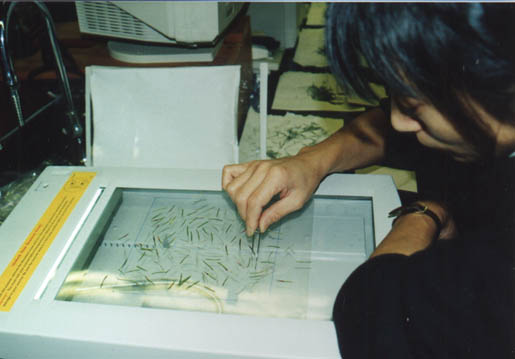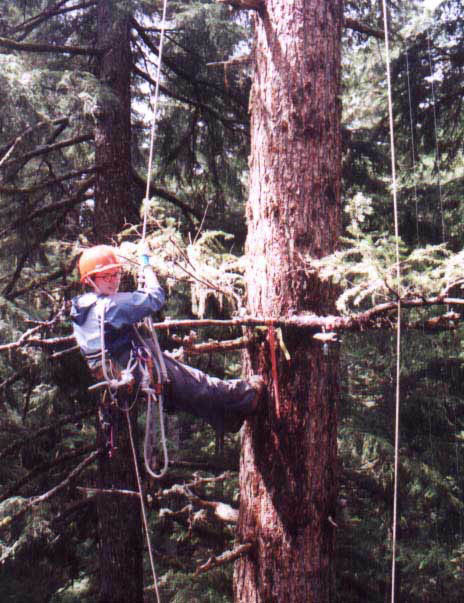Research at the Wind River Canopy Crane

At the Wind RiverCanopy Crane Research Facility, we are given the rare opportunity tostudy the crowns of live old-growth trees in close detail, and to continuouslymonitor the growth of these majestic trees. Our study involves measurementsof terminal shoot growth, production and loss of shoots and foliage, andmeasurements of crown structure, in an effort to understand how these large,old trees maintain themselves for hundreds of years.

Arbornaut, Buz Baker, measures the growth of an old-growth Douglas-firfrom the gondola.

Our goal is to discover processes of tree growth that contribute toenhancing the structural complexity of old-growth forest canopies, makingthem unique ecosystems.
CONTENTS
SUMMER '98


Our efforts to understand how old trees maintain their foliagein order to survive has taken us to new heights. The summer of '98 wasspent at the Wind River Research Natural Area climbing 60m douglas-firtrees using rope systems to measure crown attributes and to harvest wholebranches (up to 8m long) for analysis of their growth history. We hopeto elucidate the mechanisms that allow old growth trees to continue growingfor hundreds of years.



Measurement, harvesting and analysis of old-growth tree branches.



Climbers: Rebecca Paulson and Steve Foster,
and colleagues: Elaine Dinnie and Kevin Hostert.
DATA ANALYSES '99


Measurement of leaf area using the scanner and computer image analysis.
SENIOR PROJECTS 2000



Seniors, Megan Wilson, Melissa Boscolo, and Carolina Manriquez (leftto right) are studying the relationship between within-crown light environmentand crown, branch, and foliage morphology. During spring of 2000, we measuredlight in the crown of old-growth Douglas-fir trees.
LINKS
Wind River Canopy Crane HomePageCollege of Forest Resources, Universityof WashingtonCenter for Quantitative Ecologyand Resource ManagementLaboratory of ForestEcology, Department of Forestry, Kyoto UniversityOrganization for Tropical Studies
PUBLICATIONS
Ishii, H. and Ford, E.D. (In press) Persistence of Pseudotsuga menziesii(Douglas-fir), in temperate coniferous forests of the Pacific NorthwestCoast, USA. Folia Geobotanica.
Ishii, H. and McDowell, N. (In press) Age-related development of crownstructure in old coastal Douglas-fir trees. Forest Ecology and Management.
Ishii, H., Ford, E.D., Boscolo, M., Manriquez, A.C., Wilson, M.E., Hinckley,T.M. (2002) Variation in specific needle area of old-growth Douglas-firin relation to needle-age, within-crown position and epicormic shoot production.Tree Physiology 22: 31-40.
Ishii, H. and Wilson, M.E. (2001) Morphology and development of old-growthDouglas-fir crowns in the western Cascade Range, Washington. Canadian Journalof Forest Research 31: 1250-1261.
Ishii, H and Ford, E.D. (2001) The role of epicormic branching in maintainingfoliage in old Pseudotsuga menziesii (Douglas-fir) trees. CanadianJournal of Botany 79: 251-264.
Ishii, H. (2000) A canopy perspective of community dynamics of an old-growthPseudotsuga-Tsuga forest. Ph.D. Dissertation. College of Forest Resources.University of Washington. Seattle, Washington, USA.
Ishii, H. (2000) Canopy research using single-rope techniques in the temperateconiferous forests of the Pacific Northwestern USA. Japanese Journal ofEcology 50: 65-70 [in Japanese]
A paper describing canopy access techniques used in the research at WindRiver. Please see "tree climbing techinques" web page for Japanese version.Ishii, H., Reynolds, J.H., and Ford, E.D. (2000) Height growth and verticaldevelopment of an old-growth Pseudotsuga-Tsuga forest in southwesternWashington State, USA. Canadian Journal of Forest Research. 30:17-24
Our second publication from Wind River is a detailed analysis of the variabilityfound in diameter-height relationships of old-growth tree species. We alsoexplore some causes of this variability such as damaging agents and suppressionof height growth, and how these effects vary among species. We combinethis information with measurements of current height-growth rates to predictthe future development of the forest canopy.Ishii, H., Clement, J.P., and Shaw, D.C. (2000) Branch growth and crownform in old coastal Douglas-fir. Forest Ecology and Management 131: 81-91.
This is the first publication from our studies at the Wind River CanopyCrane. It presents a conceptual model of branch growth and characterizescrown types of old-growth trees for purposes of ecosystem management.







